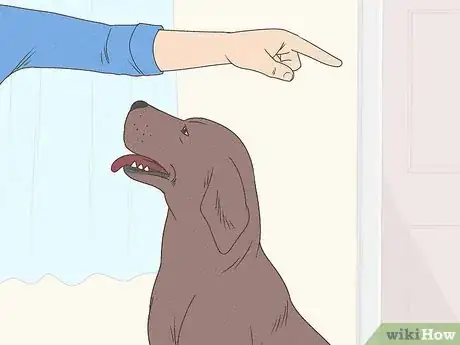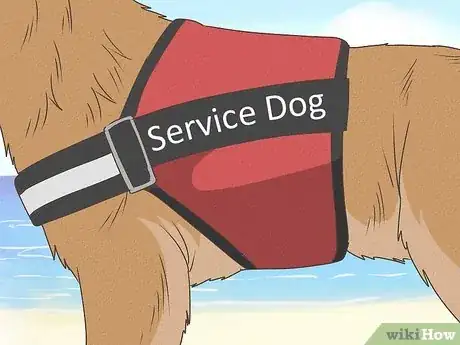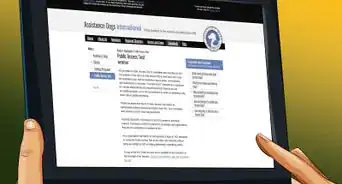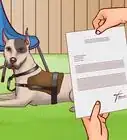This article was co-authored by wikiHow staff writer, Eric McClure. Eric McClure is an editing fellow at wikiHow where he has been editing, researching, and creating content since 2019. A former educator and poet, his work has appeared in Carcinogenic Poetry, Shot Glass Journal, Prairie Margins, and The Rusty Nail. His digital chapbook, The Internet, was also published in TL;DR Magazine. He was the winner of the Paul Carroll award for outstanding achievement in creative writing in 2014, and he was a featured reader at the Poetry Foundation’s Open Door Reading Series in 2015. Eric holds a BA in English from the University of Illinois at Chicago, and an MEd in secondary education from DePaul University.
There are 10 references cited in this article, which can be found at the bottom of the page.
This article has been viewed 1,389 times.
Learn more...
Curious if that little barking chihuahua in the airport is actually a service dog? Service dogs perform a variety of important tasks for people with physical, emotional, or mental disabilities, but some folks out there abuse the system by lying about the dog’s training. So how can you tell the real from the fake? We’ll show you! Read on to learn how to spot a fraudulent service pup.
Things You Should Know
- Service dogs are well-behaved, focused, and quiet. Fake service dogs may be reactive, loud, or playful.
- Fake service dogs will be more likely to sniff around, require redirection, or be interested in strangers and other stimuli.
- Don’t pay too much attention to vests or signs; service dogs aren’t actually required to wear special gear and there are no “certificates” for real service dogs.
Steps
Warnings
- You’re allowed to ask if an animal is a service dog and inquire about what they’re trained to do, but so long as the owner says they’re a service dog and they have an explanation, you can’t keep a service dog from entering an establishment.[17]⧼thumbs_response⧽
- You aren’t legally allowed to ask someone to prove their service dog is real, and there isn’t any kind of official certification or registration for service dogs anyway, so don’t try calling someone out for a fake service dog.[18]⧼thumbs_response⧽
References
- ↑ https://www.vet.cornell.edu/departments-centers-and-institutes/riney-canine-health-center/health-info/managing-reactive-behavior
- ↑ https://www.pewtrusts.org/en/research-and-analysis/blogs/stateline/2017/10/16/tightening-the-leash-on-fake-service-dogs
- ↑ https://www.theguardian.com/lifeandstyle/2022/feb/16/fake-service-dogs-emotional-support-animals-airplanes
- ↑ https://www.pewtrusts.org/en/research-and-analysis/blogs/stateline/2017/10/16/tightening-the-leash-on-fake-service-dogs
- ↑ https://www.theguardian.com/lifeandstyle/2022/feb/16/fake-service-dogs-emotional-support-animals-airplanes
- ↑ https://sierradelta.com/why-you-cant-pet-service-dogs/
- ↑ https://www.theguardian.com/lifeandstyle/2022/feb/16/fake-service-dogs-emotional-support-animals-airplanes
- ↑ https://www.pewtrusts.org/en/research-and-analysis/blogs/stateline/2017/10/16/tightening-the-leash-on-fake-service-dogs
- ↑ https://askjan.org/articles/Service-Dog-Breed-Exclusions-and-the-ADA.cfm
- ↑ https://www.akc.org/expert-advice/lifestyle/most-popular-service-dog-breeds/
- ↑ https://www.ada.gov/resources/service-animals-faqs/
- ↑ https://www.michigan.gov/mdcr/-/media/Project/Websites/mdcr/service-animals/documents/faq.pdf?rev=043fb9a83d06487caf659d76f13bf9b3
- ↑ https://www.ada.gov/resources/service-animals-faqs/
- ↑ https://www.ada.gov/resources/service-animals-faqs/
- ↑ https://www.ada.gov/resources/service-animals-faqs/
- ↑ https://www.servicedogregistration.org/blog/signs-of-well-trained-service-dog/
- ↑ https://adata.org/faq/how-can-i-tell-if-animal-really-service-animal-and-not-just-pet
- ↑ https://www.ada.gov/resources/service-animals-faqs/































































